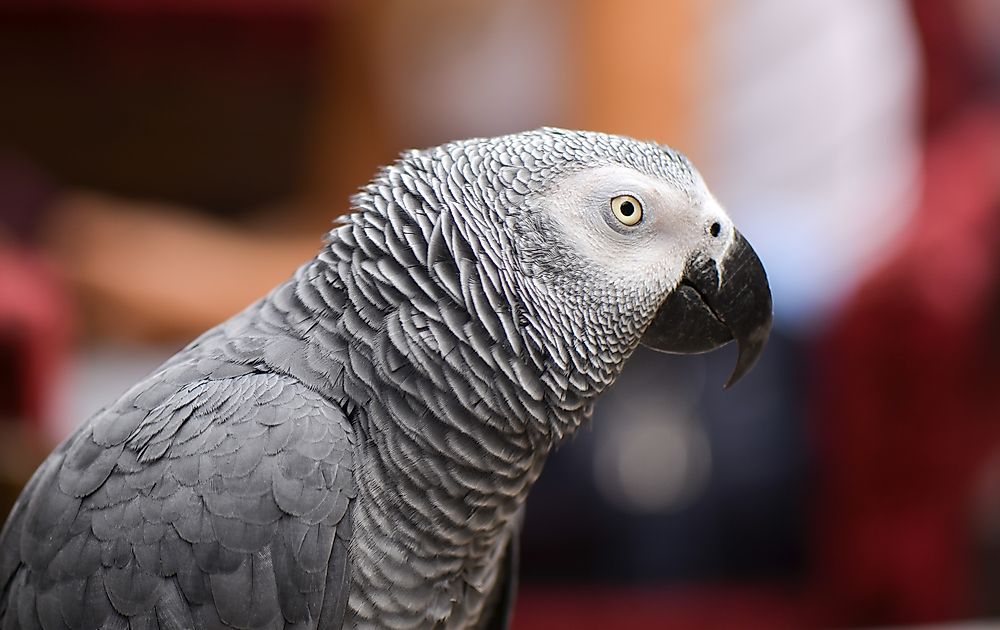Why Are The Gray Parrots Vanishing?

The Psittacus erithacus or the African gray parrot is a beautiful bird found in equatorial Africa. An endangered species, the gray parrot deserves a lot of attention. Current population estimates suggest that there are about 0.63 to 13 million birds in the wild. However, although the number appears quite significant, the terrifying fact is that the bird has been nearly eliminated from several parts of its range. A 2015 study found that the gray parrot has nearly vanished from Ghana. Local population declines have also been noted in other countries within its range like Cameroon, Burundi, Rwanda, Congo, DRC, Kenya, Togo, etc. In most cases, the declines have been severe. The decline of the gray parrot populations is estimated to be in the range of 50% to 79% in three generations or about five decades. This article explores the threats to the species and discusses them in detail.
Description Of The Gray Parrot
The gray parrot is a medium-sized bird that is predominantly gray in color. It has a black bill and red tail feathers. Selection by breeders has also generated a variety of the parrot that is predominantly red. Both sexes and the juveniles appear similar but have minor differences. The birds can survive about 40 to 60 years in captivity but their life-span in the wild is about 23 years.
Dense forests are their favored habitat but they are also found in gallery forests, savanna forests, and other more open vegetation types.
The gray parrot is mostly a frugivorous species whose diet consists of fruits, seeds, and nuts. It occasionally feeds on insects and snails. It is a ground feeder in the wild.
Gray parrots are monogamous birds that nest in the cavities in a tree. A pair needs its own tree to nest. Three to five eggs are laid and incubated for about a month. The offsprings are fed and protected by their parents till about the age of 12 weeks when they are ready to leave the nest.
Too Much Of Human Love Is Killing These Birds
Unfortunately, people’s love for the gray parrot has put it in great danger. The birds are known for their long lifespan and excellent ability to mimic a variety of sounds including human speech. As such, they are in high demand as pets in Europe, North America, and the Middle East. Instead of reducing, the demand for these birds is now coming from newer markets in China. The presence and growth of Chinese businesses in Central Africa have made it easier to illegally export the birds to the country.
According to estimates, more than 1.3 million gray parrots were illegally traded between 1982 and 2001. Given the fact that nearly 30 to 66% of the captured birds die in the process, the number of birds removed from the wild could be even higher. For example, between the late 1990s and early 2000s, Cameroon exported around 10,000 gray parrots. Given that the mortality rate of the traded birds prior to reaching the Douala airport is about 90%, it implies that around 100,000 birds were captured in the country in that period. Although there is a quota to capture the birds in each country, widespread corruption often leads to frequent violation of the rules.
Poaching Of Gray Parrots For Bushmeat And Black Magic
While the illegal pet trade is wiping out large populations of the species, the birds are also hunted by locals for other reasons. In several parts of its range, the gray parrot is hunted for bushmeat. It is also killed to supply its tail feathers, heads, and legs for use in black magic rituals or for preparing traditional medicines.
Loss Of Habitat Also Threatens The Species
Another serious threat to the gray parrot is the destruction of their habitat. The loss of forests due to illegal logging, mining, agriculture, and human settlements has deprived these parrots of their homes, the trees. Habitat loss in the range of the species can now be considered as an even bigger threat to the species than capture for the pet trade. Large trees with cavities are needed for the survival of the birds. However, in order to survive, the birds must learn to quickly adapt to habitat alterations. Some studies suggest that some populations are now found in plantations, secondary forests, and farm-bush areas. However, they become more vulnerable to capture and poaching in such more accessible habitats.











